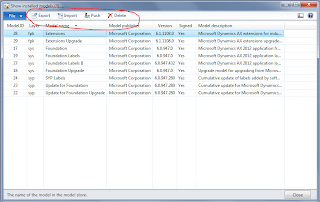There is an interface to:
- Upload a file
- Upload text as a file
- Rename file
- Delete file
- Get a list of files from an FTP server
- Download file
The class is tested to work on the client and on the server (batch)
HOW TO USE
Lud_FtpClient ftpClient = Lud_FtpClient::construct("FTP URL", "user", "pwd"); ; ftpClient.uploadText("text you want to upload", "FC/test.txt"); ftpClient.uploadFile(@"c:\IFRToolLog.txt", "FC/IFRToolLog.txt"); ftpClient.getFileList("", "xml"); ftpClient.downloadFile("/assets/ISB_PAGE 36.pdf", @"\\192.168.100.44\temp\test.pdf"); ftpClient.deleteFile("/images.jpg");
void downloadFile(str fileUrl, str destination) { System.Object ftpo; System.Object ftpResponse; System.Net.FtpWebRequest request; System.IO.Stream responseStream; System.IO.StreamReader reader; System.IO.FileStream writeStream; System.String xmlContent; System.Net.FtpWebResponse response; System.Byte[] buffer; int bufferLenght = 2048; int bytesRead; ; new InteropPermission(InteropKind::ClrInterop).assert(); try { ftpo = System.Net.WebRequest::Create("ftp://" + ftpUrl + (strEndsWith(ftpUrl, "/") ? fileUrl : "/" + fileUrl)); request = ftpo; // se vengono fatte chiamate consecutive ricreando sempre le credential ogni tanto va in errore (Bad request) // per evitare il problema keepAlive = false, ma così va più lento. Con questo hack se la classe non viene ricreata // ogni volta dovrebbe andare meglio if(!credential) { credential = new System.Net.NetworkCredential(username, password); request.set_Credentials(credential); request.set_KeepAlive(false); } else { request.set_Credentials(credential); request.set_KeepAlive(true); } request.set_Method("RETR"); // "Bypass" a HTTP Proxy (FTP transfer through a proxy causes an exception) request.set_Proxy( System.Net.GlobalProxySelection::GetEmptyWebProxy() ); ftpResponse = request.GetResponse(); response = ftpResponse; responseStream = response.GetResponseStream(); buffer = new System.Byte[bufferLenght](); writeStream = new System.IO.FileStream(destination, System.IO.FileMode::Create); bytesRead = responseStream.Read(buffer, 0, bufferLenght); while (bytesRead > 0) { writeStream.Write(buffer, 0, bytesRead); bytesRead = responseStream.Read(buffer, 0, bufferLenght); } writeStream.Close(); response.Close(); } catch(Exception::CLRError) { throw error(this.getClrErrorMessage()); } CodeAccessPermission::revertAssert(); }









